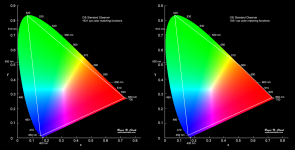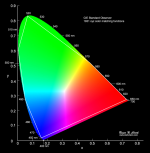- Joined
- Apr 16, 2013
- Messages
- 80
- Points
- 8
hi... 589 nm yellow laser DPSS already exists.... but is there a yellow laser direct diode...? Will he come ?

Follow along with the video below to see how to install our site as a web app on your home screen.
Note: This feature may not be available in some browsers.



Arguably not yellow but lime green. However it is progress in the right direction.there IS a yellow laser diode, it lases at 565nm and was made using MgZnCdSe https://www.photonics.com/Articles/Laser_Diode_Emits_Yellow-Green_Light/a13986


We live in the age of AI and fast computing. You wouldn't necessarily need a 4th channel. TV's are able to compute each frame nowadays, you could just use an AI algorithm to decide when and where to apply a colour boost based on that frames data input. Therefore you can still have RGB data without too much compromise. Not too hard to program either. You just set thresholds based on conditions that correspond to RGB value of yellows, oranges and reds.Sadly not too likely. There was once a television with a 4 channel HD display. In theory, it should have been able to show much more vivid oranges, yellows, and greens. However, it could not work, because all colour information fed to the display was in RGB, so the added technology was useless.
Any future projector would suffer from the same problem. You'd need to feed it data that actually contains extra colour information for a fourth channel in order for the image to be affected in any positive way, or else the extra hardware just makes the resolution a little worse, as there is a functionally dead 25% of each pixel taking up valuable real estate on the screen and 25% more weight in the colour engine that is essentially unused.
Green is more highly visible. As pointed out, UV and IR are much more useful for hardware. So, there will never be a yellow diode laser in the mass market.
Even if someone stumbled upon a yellow laser diode tomorrow, which won't happen, they'd be another item accessible only to academics for federal-grant-levels of money ($$$,$$$.$$). It's okay to be optimistic, but from any sort of realistic standpoint, this will never happen.
That's not really how that works, though.We live in the age of AI and fast computing. You wouldn't necessarily need a 4th channel. TV's are able to compute each frame nowadays, you could just use an AI algorithm to decide when and where to apply a colour boost based on that frames data input. Therefore you can still have RGB data without too much compromise. Not too hard to program either. You just set thresholds based on conditions that correspond to RGB value of yellows, oranges and reds.

